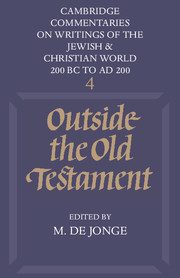Book contents
- Frontmatter
- Contents
- General Editors' Preface
- Editor's Foreword
- Acknowledgements
- Abbreviations
- General Introduction
- Pseudo-Philo, Liber Antiquitatum Biblicarum
- The Ethiopic Book of Enoch
- The Testament of Abraham
- The Testaments of the Twelve Patriarchs
- Joseph and Aseneth
- The Book of Jubilees
- The Testament (Assumption) of Moses
- The Psalms of Solomon
- The Martyrdom of Isaiah
- The Syriac Apocalypse of Baruch
- Paraleipomena Jeremiou
- The Testament of Job
- Index
The Ethiopic Book of Enoch
Published online by Cambridge University Press: 05 June 2012
- Frontmatter
- Contents
- General Editors' Preface
- Editor's Foreword
- Acknowledgements
- Abbreviations
- General Introduction
- Pseudo-Philo, Liber Antiquitatum Biblicarum
- The Ethiopic Book of Enoch
- The Testament of Abraham
- The Testaments of the Twelve Patriarchs
- Joseph and Aseneth
- The Book of Jubilees
- The Testament (Assumption) of Moses
- The Psalms of Solomon
- The Martyrdom of Isaiah
- The Syriac Apocalypse of Baruch
- Paraleipomena Jeremiou
- The Testament of Job
- Index
Summary
Enoch literature
The number of writings associated with the name of Enoch is an indication of the fascination which this figure held for later generations, a fascination aroused no doubt by the enigmatic statement of Gen. 5:24, ‘Having walked with God, Enoch was seen no more, because God had taken him away’ (cp.Ecclus. 44:16; 49:14; Heb. 11:5). Three writings in particular are important, known respectively as the Ethiopic, the Slavonic, and the Hebrew book of Enoch, or, for convenience, as 1, 2 and 3 Enoch. The first of these is so called because it is only in the Ethiopic language that a complete version has come down to us. The second, a work composed in Greek but extant only in two Slavonic versions, describes Enoch's ascent through the heavens to the presence of God and the instructions he gave during a temporary return to earth; at the end of the book Enoch is taken back to heaven, this time permanently. The Slavonic book shows some points of contact with 1 Enoch and perhaps dates from the first century ad. The third writing, a somewhat later work composed in Hebrew, is important for the development of Jewish mysticism.
The Ethiopic Enoch
In the form known to us from the Ethiopic version 1 Enoch consists of five main sections: (1) The book of Watchers (chapters 1–36). (2) The Parables of Enoch (chapters 37–71). The contents of these two sections are summarized below, pp. 29 f, 43 f. (3) The book of Astronomy (chapters 72–82).
- Type
- Chapter
- Information
- Outside the Old Testament , pp. 26 - 55Publisher: Cambridge University PressPrint publication year: 1986
- 1
- Cited by



